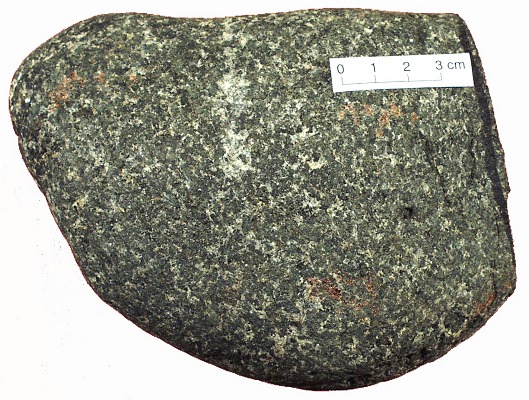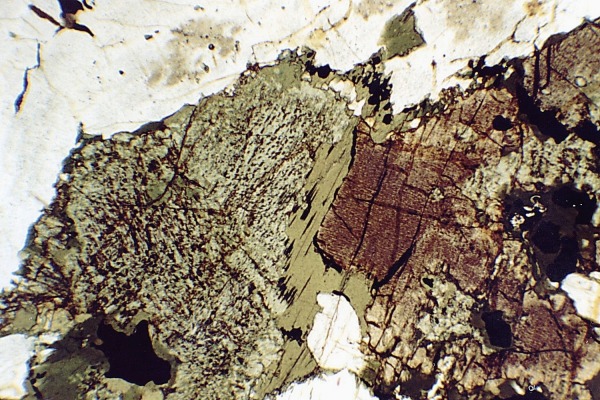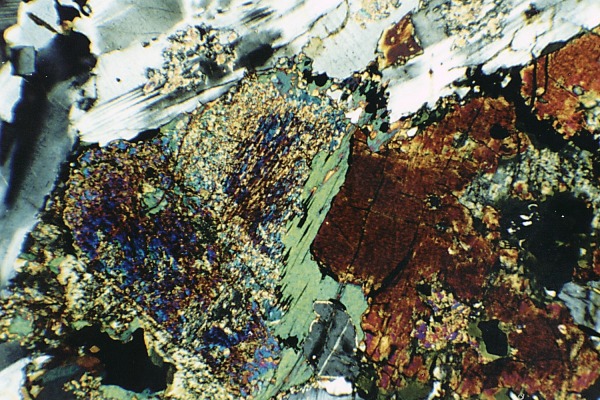
| Home | Geological History | Stratigraphy | Area map | Rock Index | About |
| Scourie | Achmelvich | Laxford | Clachtoll | Stoer | Assynt | Skiag Bridge | Glencoul | Knockan | Borralan | Ledmore |
Sampled from the "Graveyard Dyke", Scourie.

![]() Gabbro, Scourie dyke in Lewisian Gneiss Complex,
Scouriemore
Gabbro, Scourie dyke in Lewisian Gneiss Complex,
Scouriemore
The dyke is a vertical sheet of igneous rock that cuts
through the Lewisian gneisses. This particular one, known
to geologists as the "graveyard dyke", is about 40 metres
wide. Because it weathers more rapidly than the surrounding
felsic gneisses, it has been hollowed out by the sea,
forming this small bay just west of Scourie village.
Here, we are looking westwards along the southern edge of
the dyke. The students are looking at the outcrop of the
dyke itself, and the southern margin of the dyke is marked by the steep
vertical face at the left-hand side of the beach.

![]() Gabbro, Scourie dyke in Lewisian Gneiss Complex,
Scouriemore
Gabbro, Scourie dyke in Lewisian Gneiss Complex,
Scouriemore
This rock shows an igneous texture of blocky dark pyroxene
crystals with light-coloured feldspar occupying the
irregular spaces between the pyroxenes. The texture
indicates that pyroxene started crystallizing first from
the magma, before the feldspar. (Many gabbros show the
opposite relationship, and have oblong feldspars with
pyroxene filling the space between them). There is also a
little garnet in clusters and streaks of red crystals. This
did not crystallize from the magma, but grew later in the
solid rock.
This sample comes from near the centre of the dyke. Nearer
to its margins, where the magma cooled more rapidly, the
rock has a much finer grain size.

![]() Gabbro, Scourie dyke in Lewisian Gneiss
Complex, Scouriemore
Gabbro, Scourie dyke in Lewisian Gneiss
Complex, Scouriemore
Most of the rock is made of greenish and reddish pyroxenes
and clear feldspar. However, in detail the pyroxene is not
very fresh, and has partly broken down to hornblende and
dark iron-rich material. This shows that the rock suffered
some metamorphism after it was intruded. Radiometric dating
on this dyke reveals that it was intruded 2000 million
years ago, and the later mineral breakdown happened at 1750
million years, during the Laxfordian episode.
Plane polarized light, field of view 4 mm across

![]() Gabbro, Scourie dyke in Lewisian Gneiss
Complex, Scouriemore
Gabbro, Scourie dyke in Lewisian Gneiss
Complex, Scouriemore
In this view the spongy texture of the pyroxene (centre
left, and right) shows where it began to break down. The
crystal outlines of the feldspar and pyroxene are not as
regular and distinct as they would have been in the fresh
igneous rock.
Crossed polars, field of view 4 mm across
| Scourie | Achmelvich | Laxford | Clachtoll | Stoer | Assynt | Skiag Bridge | Glencoul | Knockan | Borralan | Ledmore |
| Home | Geological History | Stratigraphy | Area map | Rock Index | About |
D.J. Waters, Department of Earth Sciences, May 2003